Tracing my Grandfather’s World War II role in a B-24 Liberator

Sharing Your Family’s World War II Story
August 23, 2017
Finding Courage in the Midst of Adversity
September 11, 2017Today’s article is from our guest writer, Leah Toeniskoetter, who shares her unique experience connecting with her grandfather’s World War II service story.
When I signed in to fly in a B-24 Liberator called “Witchcraft” with the Wings of Freedom, I didn’t know what to expect. Their fully restored World War II airplanes tour all over the country and offer people the chance to experience the aircraft up close and personal. My paternal grandfather had been a B-24 navigator, flying over twenty missions when he was only twenty years of age with what was then the Army Air Corps. A dear friend of mine, who had known this family connection, bought us tickets for a thirty- minute flight over the San Francisco Bay in the same type of plane. So there I was at Moffett Field on May 21, 2017, a sunny, windy Sunday morning, and I would soon be unexpectedly overwhelmed by this experience.
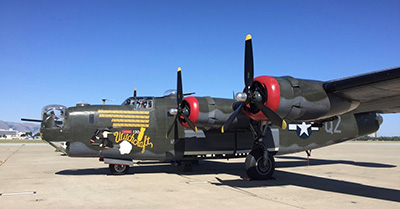
The B-24 Liberator “Witchcraft”
While the outside of the B-24 was familiar from pictures, films and a museum display, I had never seen the fully intact inside or outside of this World War II plane. The closest I’d come was in The National WWII Museum in New Orleans a few years ago where they had displayed a forward fuselage of one of the nearly 19,000 B-24 Liberators built for the war. Now at Moffett Field, I suddenly felt small standing next to the entire aircraft.
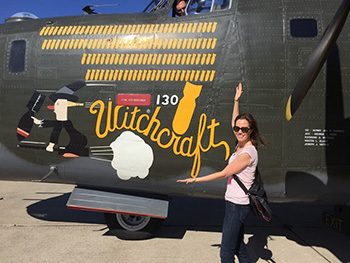
Seeing the inside of the plane was an even bigger surprise. Previously every plane I’d been on was either built for passengers or military cargo. I had flown in a Cessna and commercial planes and had seen tanks inside C-5 military cargo aircraft. So my expectation for the inside of the B-24 was that it too would be a relatively spacious and open cavern. This image quickly began to crumble as our guide for the day explained the important details of our thirty- minute flight in “Witchcraft” which was soon to depart.
He gave us these few rules for the flight. 1) A loose hat or glasses will have a high probability of flying off, particularly if you put your head out the open window. 2) To see all parts of the plane you must be confident and able to crawl through very small spaces. 3) Do not step or stand on the doors that open towards the ground. They may open and cause you to fall out of the plane. 4) You will unlikely be able to hear the pilot’s voice when in flight because of the noise, so pay attention to messages being passed from the front through your fellow passengers to the rear as we get closer to landing.
Armed with these important instructions, our small group walked under the plane to crawl in, around, and over a myriad of obstacles to find our ‘seats’. Where we were to sit was indicated by the thick, waist-strap seat belts protruding from the floor and walls. For takeoff, my friend and I decided to sit on the floor in the rear of the plane, looking towards the tail gunner’s seat.
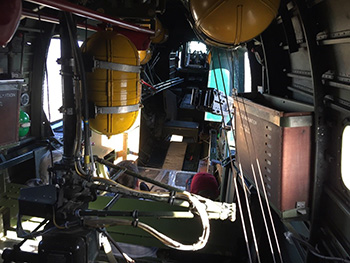
The rear of the plane, looking towards the tail gunner position. You can see the heads of those passengers seated on the floor for takeoff and landing.
The rear of the plane, looking towards the tail gunner position. You can see the heads of those passengers seated on the floor for takeoff and landing.One of the openings along the side had a replica of a machine gun in it and of course, no windows. This opening allowed for the full movement of the guns in combat. As the propellers started, the noise increased and the air began to rustle around us as we slowly made our way toward the end of the runway. With another blast of noise, the four propellers went into full force, and our aircraft was rolling down the runway. Then almost surprisingly, we were up in the air.
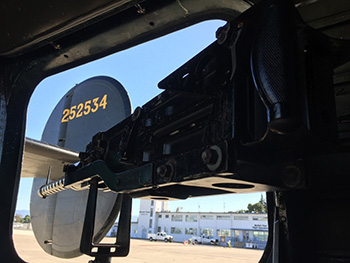
View from one of two open windows in the rear of the plane
Once we were airborne, the seat belts came off and we were free to move around. Just the combination of the wind, noise and visuals from the open windows was a moving, visceral experience. Heading to the rear of plane where the tail gunner sat, I couldn’t help but notice what a small space it was. It was so hard to imagine sitting there for hours on a mission, or much less in the crammed ball turret gunner positions below the plane. Thankfully the large open windows allowed great views of the land we were flying over.
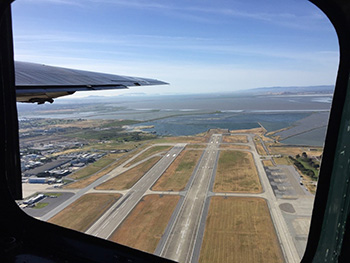
View out the open window in the rear of the plane
With enough time spent in the back of the plane, we began making our way towards the front, along the ‘plank.’ This was the narrow walkway that connected the rear and front of the plane and was in between the bombs stationed for dropping.
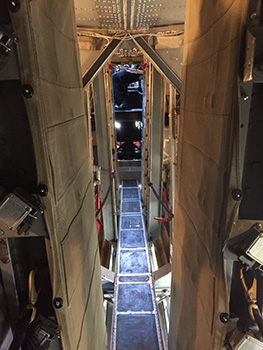
The ‘plank,’ the narrow connection through the stored bomb area between the rear and front of the plane.
The front portion of the plane was split into a few levels. On the top were the pilot and co-pilot seats along with seats for the top turret gunner and flight engineer. The bottom area held the seats for the nose gunner, bombardier and navigator. After reaching the front compartment, I crawled (literally) down into the seat where my grandfather would have been flying as the navigator. An even smaller space than that in the rear, it was surrounded by switches and instruments to the sides and windows to the front.
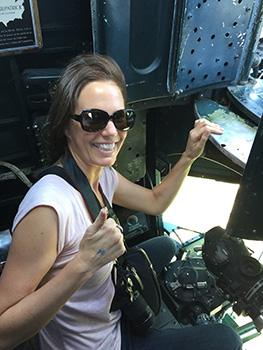
Sitting in the navigator seat
Once in that seat, the connection to my grandfather and his vital World War II service became real. I sensed for the first time a small aspect of his experience as a navigator. He had never talked about his war activities when he was with us, and even when I asked him about it later in life, he didn’t really care to talk about it. Knowing that he had been in that seat for the twenty plus missions from England to Europe, and that he had ensured the crew safely made it to their destinations, was indeed hard to imagine. But that reality brought me a great sense of pride for him and his efforts. While, it was impossible for me to know his feelings as the twenty-year-old navigator of that plane, I was very appreciative to be this connected to his World War II adventures.
With that moment and experience becoming the highlight of this flight, I crawled back to the rear of the plane for a final buckle in and landing. As we prepared to land, I closed my eyes and tried to visualize how this must have felt for my grandfather. While I will never know, I am grateful for my opportunity to experience this B-24 flight first-hand. I encourage you to take a flight into World War II history and be prepared to come away surprised and moved.
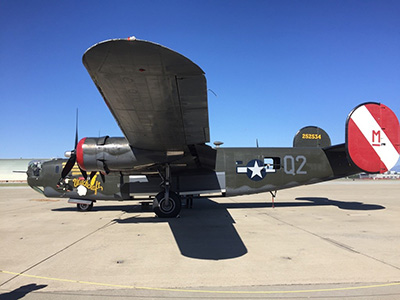
The Wings of Freedom program is supported by the Collings Foundation, an educational non-profit whose mission is to “organize and support ‘living history’ events that enable Americans to learn more about their heritage through direct participation.” http://www.collingsfoundation.org/flight-experiences/
A special thanks to Leah Toeniskoetter, Senior Manager of Corporate Citizenship at Deloitte, U.S. West Region for writing this guest blog. I hope her experiences will inspire you to take flight and discover your family’s World War II stories.

